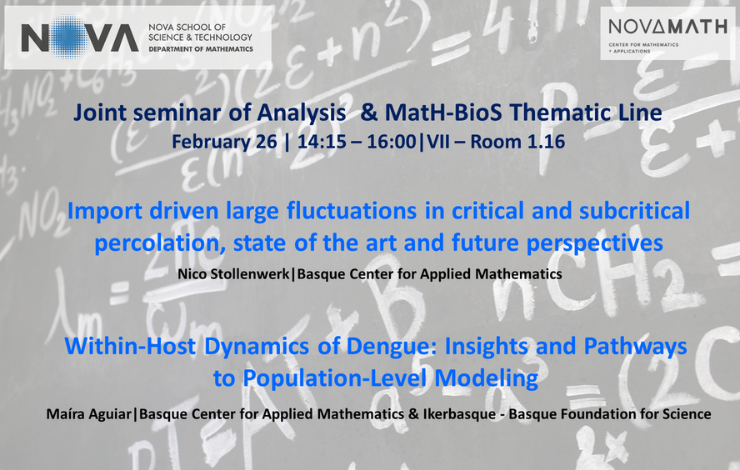20-02-2025

The Center of Mathematics and Applications (NOVA Math), promote the Joint seminar of Analysis & MatH-BioS Thematic Line with the title: “Import driven large fluctuations in critical and subcritical percolation, state of the art and future perspectives” and “Within-Host Dynamics of Dengue: Insights and Pathways to Population-Level Modeling”. Nico Stollenwerk (Basque Center for Applied Mathematics) and Maíra Aguiar (Basque Center for Applied Mathematics & Ikerbasque - Basque Foundation for Science) are the speakers.
Speaker 1
Nico Stollenwerk (Basque Center for Applied Mathematics).
Time: 14:15 – 15:00 - Location: Room 1.16, Building VII.
Title: Import driven large fluctuations in critical and subcritical percolation, state of the art and future perspectives
Abstract: After introducing the notions of directed percolation (with a prime example in epidemiology being the SIS spatially extended stochastic system at and around the epidemiological threshold) and dynamical isotropic percolation (with the prime example being the SIR system), we show a simple renormalization scheme in the time domain to describe self-similarity at criticality and scaling near criticality.
The we will charactrize the large fluctuations in subcritical epidemiological systems, which are driven by small import (in the limit of import vanishing), which is important in practical applications like invasion scenarios of vector-borne diseases [1], as well as prviosuly investigated during the COVID-19 pandemic after lock-down lifiting, avoiding supercitical explosion of infected but approaching the epidemiological threshold [2]. Technical aspects have been tackled since some time [3] (like Fock space representation of stochastic processes and path integrals), but now adjusted to the present scientific questions, relevant for the practical applications and data analysis.
References
[1] Stollenwerk, N., Mateus, L., Steindorf, V., et al. (2024). Evaluating the risk of mosquito-borne diseases in non-endemic regions: A dynamic modeling approach (under review).
[2] Aguiar, M., Bidaurrazaga Van-Dierdonck, J., Mar, J., et al. (2021). Critical fluctuations in epidemic models explain COVID-19 post-lockdown dynamics. Scientific Reports, 11: 13839.
[3] Stollenwerk, N., Jansen, V. (2011). Population Biology and Criticality: From critical birth–death processes to self-organized criticality in mutation pathogen systems. Imperial College Press, World Scientific, London.
Coffee Break (15:00 – 15:15)
Speaker 2
Maíra Aguiar (Basque Center for Applied Mathematics & Ikerbasque - Basque Foundation for Science).
Time: 15:15 – 16:00 - Location: Room 1.16, Building VII.
Title: Within-Host Dynamics of Dengue: Insights and Pathways to Population-Level Modeling
Abstract: With over one-third of the global population at risk, dengue fever poses a significant public health challenge. The disease is caused by four antigenically distinct but related serotypes, and its severity is closely tied to the individual’s immunological status, seronegative or seropositive, prior to infection. While primary dengue infections are often mild or asymptomatic, secondary infections with a heterologous serotype significantly increase the risk of severe disease due to the antibody-dependent enhancement (ADE) process.
We present a modeling framework to capture the dynamics of dengue immune responses mediated by antibodies. Our model reproduces the viral load and antibody production dynamics observed in primary and secondary infections, aligning with findings from empirical immunology studies. This framework lays the foundation for future extensions to explore the interplay between within-host immune responses [1-3] and population-level disease dynamics [4]. Ultimately, such advancements could inform strategies to evaluate the impact of imperfect dengue vaccines and other public health interventions.
References
[1] Anam, V., Guerrero, B.V, Srivastav A.K., et al. (2024). Within-host models unravelling the dynamics of dengue reinfections. Infectious Disease
Modelling, 9(2) : 458-473. https://doi.org/10.1016/j.idm.2024.02.004
[2] Anam, A., Sebayang, A.A., Fahlena, H., et al. (2022). Modeling dengue immune responses mediated by antibodies: Insights on the biological parameters to describe dengue infections. Computational and Mathematical Methods, Article 8283239. 10(9): 941 https://doi.org/10.1155/2022/8283239
[3] Sebayang, A.A., Fahlena, H., Anam, V., et al. (2021). Modeling Dengue Immune Responses Mediated by Antibodies: A Qualitative Study. Biology 10:941. https://doi.org/10.3390/biology10090941
[4] Aguiar, M., Ballesteros, S., Kooi, B.W., Stollenwerk, N. (2011). The role of seasonality and import in a minimalistic multi-strain dengue model capturing differences between primary and secondary infections: complex dynamics and its implications for data analysis. Journal of Theoretical Biology,
289:181-196. https://doi.org/10.1016/j.jtbi.2011.08.043